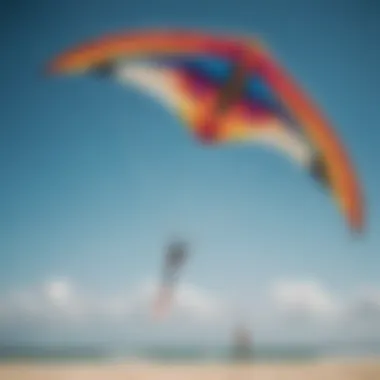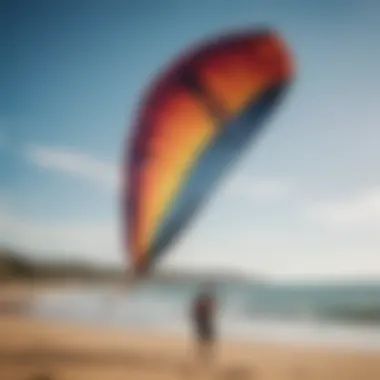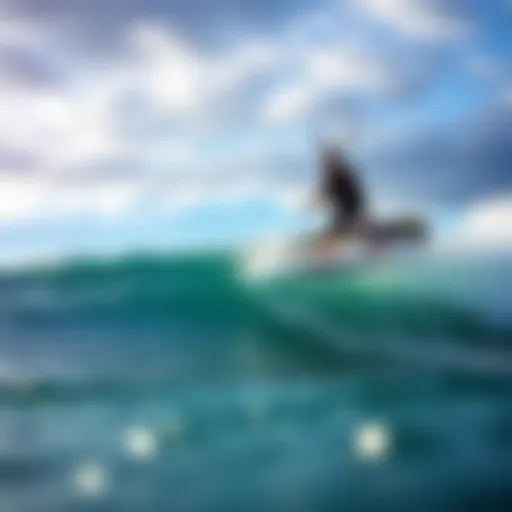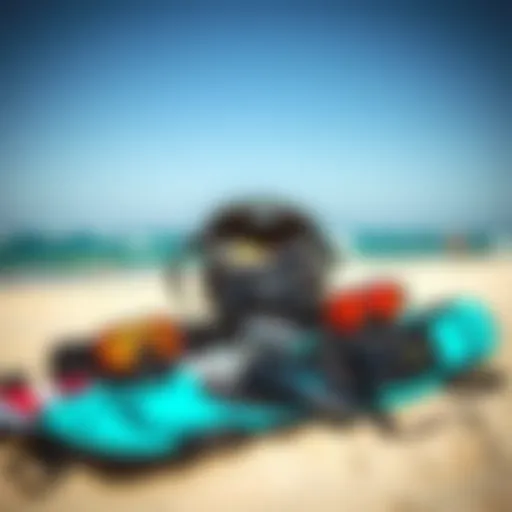Selecting the Right Kite Size for Kitesurfing


Intro
Choosing the right kite size for kitesurfing can be a real head-scratcher, especially for those just dipping their toes into the sport. It’s not merely a matter of picking a number from a chart; various aspects come into play that could greatly affect your performance on the water. From understanding the wind conditions to assessing your weight and skill level, all of these factors weave together in a tapestry that affects how your kite performs.
This guide aims to break down everything you need to know about kite size, ensuring that whether you're a rookie fresher than a spring rose or a seasoned pro, you're well-equipped for success on the waves.
Gear Insights
Latest Gear Reviews
In the world of kitesurfing, gear choices are aplenty and can often be overwhelming. A well-selected kite is akin to finding the right pair of shoes; the perfect fit enhances your experience while the wrong one can lead to discomfort and inefficiency.
For example, the Duotone Neo has made waves in the community for its versatility and performance across a wide range of wind conditions. Riders laud its ability to handle both lighter winds on the beach and stronger gusts that come barreling through over open waters. On the flip side, if you’re after something that specializes in freestyle, the Cabrinha Switchblade might tick all your boxes with its superb lift and responsiveness, enabling jaw-dropping tricks.
Additionally, brands like North Kiteboarding have integrated innovative features in their latest models. Their kites have adjustable bridles, which adapt to changing winds, making them suitable for both casual cruising and the more extreme stunts.
Essential Gear for Beginners
When stepping into kitesurfing, having the right gear is crucial not just for performance but also for your safety. Some must-have items include:
- A kite with a shorter aspect ratio: This tends to provide better stability, perfect for those still mastering the basics.
- A reliable harness: A comfortable yet secure harness is essential for connecting with the kite easily.
- Proper footwear: Look for booties that offer some grip and warmth, especially if you’re riding in chillier waters.
Investing time in selecting the right gear will reward you with smoother sessions, allowing for a more enjoyable ride.
"The gear you choose can be the difference between a thrilling session and a frustrating fight with the wind."
Techniques and Tips
Understanding Wind Conditions
Wind conditions can be fickle and are arguably one of the most vital elements that dictate kite size. Understanding how wind works on a particular day can keep you in the sweet spot, making sure you don’t pick a kite that’s too big or too small. The general rule of thumb is: stronger winds require smaller kites while lighter winds call for larger kites.
Keep an eye on surface wind while also considering what’s happening a little higher up. Sometimes it feels calm on the beach, but up high, there could be a more robust current. A wind gauge can be your best friend in such cases.
Safety Practices for Kiteboarders
As you venture deeper into the sport, prioritizing safety is paramount. Always respect the conditions and know when to call it a day. Some practices worth incorporating are:
- Learn to self-rescue: Familiarize yourself with self-rescue techniques in case things go awry.
- Check gear: Regularly inspect your gear for any wear and tear to avoid potential mishaps.
- Ride with a buddy: Having a fellow kitesurfer nearby means there is someone to assist if you find yourself in a bind.
Navigating the waters of kitesurfing can be thrilling, but understanding kite sizes, gear, techniques, and safety practices will set you on the right course for an exhilarating kitesurfing experience.
Preamble to Kite Size
Selecting the right kite size in kitesurfing is akin to choosing the right tool for a job; the outcome can be dramatically different based on that primary choice. This section lays the groundwork for understanding why kite size is not just a trivial detail— it’s pivotal for performance, safety, and enjoyment on the water.
Kite size doesn’t function in isolation; it intertwines with an array of elements, such as wind conditions, rider weight, and experience levels. By grasping these factors, both rookies and seasoned enthusiasts can make informed decisions, which ultimately leads to a better kitesurfing experience.
Definition and Importance
In essence, kite size refers to the surface area of the kite itself, usually measured in square meters. The size greatly influences how the kite behaves in different wind conditions—larger kites capture more wind, providing more lift, whereas smaller kites require stronger winds to perform effectively.
Understanding kite size is paramount for several reasons:
- Performance Optimization: Choosing the right size ensures that riders maximize their potential on the water, whether they're soaring high or carving through waves.
- Safety: Using a kite that’s too large for the current conditions can cause overpowering, leading to dangerous situations. Conversely, using one that’s too small can hinder performance and create a frustrating experience.
- Adaptability: Riders who understand kite sizes can adjust their gear based on fluctuating environmental factors, ensuring they remain in tune with nature and ride efficiently.
The Role of Kite Size in Performance
Kite size is directly correlated to how well a rider can navigate through various scenarios on the water. Here’s how different sizes contribute to overall performance:


- Lift and Power: Bigger kites generate more lift, crucial for jumps and tricks. In flat conditions, a larger kite can push the rider through transitions with ease. On the other hand, in gusty winds, a smaller kite might prove to be better suited, reducing the likelihood of being overpowered.
- Speed Control: Smaller kites are typically faster and more agile. They can turn quickly, allowing advanced riders to perform tight maneuvers. Yet, those same kites might not offer the stability that beginners need to build their confidence.
- Sustainability in Various Conditions: Winds are variable. A rider's skill in choosing the appropriate kite size enables them to adapt to changing wind patterns, which means more time on the water rather than being sidelined by unmanageable conditions.
Ultimately, the intricate dynamics of kite size come into play once riders hit the water. Grasping how size impacts performance can transform a novice's learning curve and elevate experienced riders toward new heights.
Factors Affecting Kite Size Selection
The choice of kite size is no small potatoes in the world of kitesurfing. It can mean the difference between a thrilling ride or fighting against the elements, like a fish out of water. This section dives into the various elements that play a crucial role in determining the best kite size for different riders and situations.
Wind Conditions
A kite can only perform well in a wind condition suited for its size. If the wind's too light, a smaller kite might not catch enough breeze, while a kite too large can overpower the rider in high winds, causing a challenging experience.
Understanding Wind Speed
Understanding wind speed is like reading the pulse of the ocean. It directly correlates with how a kite performs. Light winds typically range from one to twelve knots, while winds from twelve to twenty-five knots are considered moderate. If you’re out there in anything above twenty-five knots, you’re really pushing it with a larger kite.
When the wind is light, opting for a larger kite can help you get better lift, while smaller kites are useful in strong winds to prevent being dragged around like a ragdoll. The significant characteristic here is that kites vary considerably in power and handling based on wind speed, making this an invaluable factor.
"Kite size without proper wind knowledge is like a ship without a sail; you won't get very far."
Assessing Consistency in Wind Patterns
Wind patterns can be as fickle as a cat on a hot tin roof. Before heading out, it's essential to note whether the wind is consistent or prone to sudden gusts. Constant winds simplify your decision-making process, whereas unpredictable patterns mean extra caution is needed when selecting your kite size.
Identifying reliable wind patterns helps predict the optimal kite size. A steady breeze often lends itself to more enjoyable kitesurfing, allowing riders to focus on technique rather than constant adjustments to tackle gusts swinging like a pendulum.
Rider Weight
The weight of the rider is another cog in the wheel when it comes to kite size selection. The balance between the rider's body weight and the kite's lift plays a pivotal role in performance and safety.
Weight-Size Correlation
There's a straightforward link with rider weight and kite sizing. Heavier riders require larger kites to generate enough lift, while lighter riders can manage with smaller kites. While it's not a one-size-fits-all scenario, as personal preference also circles in, general guidelines do exist.
Lighter riders will often find that their smaller kites offer better control and agility. In contrast, larger kites offer heavier riders not only the necessary lift but also added power during their tricks and jumps. It’s all about matching the kite to the rider’s weight to enhance the overall riding experience.
Impact of Rider Skill Level
Of course, skill level factors in as much as weight. Novices might find a smaller kite more user-friendly, reducing the risk of overpowering winds, while advanced riders can handle a more extensive range of kite sizes.
Understanding the impact of rider skill level helps ensure that the kite size enhances, rather than impedes, the learning curve. More experienced riders can enjoy the challenge and thrill of larger kites, while newcomers can focus on mastering basics without being overwhelmed.
Rider Experience Level
Experience is more than just a number in kiteboarding; it deeply influences choices regarding kite size. The general difference between beginners and advanced riders isn't merely technical skill but also mental fortitude in handling various kite sizes.
Beginners vs. Advanced Riders
Beginners often benefit from smaller, more manageable kites that offer easier handling as they adapt to the sport. A smaller kite allows learners to concentrate on balance and control without the daunting task of managing excessive power. In contrast, advanced riders might gravitate toward larger kites that offer the enhanced performance needed to execute tricks and push their limits.
Choosing kite sizes based on experience allows individuals to strike a balance between comfort and performance, progressively enhancing their skills.
Adapting to Personal Strengths
Another key aspect of rider experience is the need for tailored kite sizes that suit individual strengths. Not every rider is the same, and someone who is particularly adept at harnessing wind energy may steer toward a larger kite.
Understanding personal strengths is crucial in selecting kite sizes that amplify natural skills. This individualistic approach can lead to a truly enhanced riding experience, encouraging riders to explore their capabilities rather than be limited by generic recommendations.
Kite Design and Shape
The design and shape of a kite sway heavily on its performance. Various kite styles cater to specific conditions and riding styles, making knowledge of these designs imperative.


Types of Kites Available
The primary types of kites include inflatable kites and foil kites, each boasting distinct advantages and limitations. Inflatable kites, popular for their adaptability, are easier to relaunch after a crash and provide stability, essential for all types of riders. Foil kites, on the other hand, are highly efficient in light winds and can offer increased performance during more extreme conditions.
Identifying what type of kite suits your riding novice or expert level is a clear gain in performance and comfort, no matter what the conditions throw at you.
Influence of Aspect Ratio
The aspect ratio, the width divided by the height of a kite, can drastically shape performance. Kites with a high aspect ratio are designed for speed and advanced performance while offering more lift and less drag in strong winds. Conversely, low aspect ratio kites provide better stability and room for maneuverability in less intense conditions.
Understanding aspect ratios provides riders with an additional layer of knowledge essential for selecting the right kite that matches their riding style and conditions.
Environmental Considerations
Finally, the environmental context - the water conditions and local geography - brings in other nuanced factors to the kite size equation.
Water Conditions
Flat waters versus choppy waves require different approaches. While flat conditions might favor larger kites that catch wind steadily, choppy waters call for kites that can maneuver effectively without compromising rider stability.
Understanding how water conditions impact kite performance can lead to better choices, ensuring smoother rides rather than grappling with something ill-suited.
Local Geography
Local geography can't be overlooked either. A rider in an open beach will experience different wind dynamics compared to someone kiting in a protected cove. Terrain, trees, and buildings can shift wind patterns dramatically and affect performance drastically.
By thoroughly assessing local geography, kiteboarders can better prepare for the nuances of their riding environment, thus facilitating informed kite size selection.
The marriage between kite size and the surrounding conditions might not be an exact science, but understanding these factors allows kiteboarders to make reasoned, effective choices.
Kite Size Recommendations
When it comes to kitesurfing, knowing the right kite size for the conditions you’re facing is like having the secret sauce for a gourmet dish. The kite you choose can greatly influence your ability to enjoy the ride as well as your overall performance. Getting this aspect right ensures not only an exhilarating experience on the water but also enhances your safety.
In this part of the article, we delve into practical kite size recommendations. This section serves not only as a guide but also as a tool to help you adapt and flourish in various conditions. The focus will be on understanding the dynamics of wind, as well as relating them to riders of different weights. It becomes apparent that kite size is more than just a number—it's a combination of experience, physics, and a sprinkle of personal flair.
General Guidelines Based on Wind
Light Wind Scenarios
Light wind scenarios call for specific kites that are designed to catch the gentlest of breezes. Typically, a larger kite is needed in these situations to harness the little wind available effectively. Imagine standing out on the water with a kite that’s too small; you'll likely find yourself struggling against the elements, unable to generate enough lift.
The key characteristic of light wind conditions is they require finesse rather than force. A large kite glides beautifully through soft breezes, enabling riders to feel the thrill of kitesurfing, even when the wind seems almost shy. One unique feature of these kites is their ability to stay airborne at lower speeds, which is an undeniable advantage when facing calmer waters. However, the downside lies in the danger of overestimating the wind; a kite that’s too big can lead to difficulty controlling your ride when wind picks up unexpectedly.
Moderate to Strong Wind Conditions
On the flip side, moderate to strong wind conditions demand a different approach altogether. Here, smaller kites take center stage as they cut through the gusts with precision. The beauty of choosing a smaller kite in these scenarios is that they provide a greater sense of control, allowing experienced kiteboarders to perform advanced maneuvers without fear of being tossed about like a rag doll.
A notable advantage of smaller kites is they are more responsive, giving riders the ability to adapt quickly to changing winds. They also tend to minimize the risk of being overpowered, which is essential for both safety and enjoyment. However, a smaller kite may require riders to work a bit harder to maintain lift, especially if they’re navigating through choppy waters.
Specific Recommendations by Rider Weight
Lightweight Riders
When it comes to lightweight riders, one cannot underestimate the importance of matching their size with the appropriate kite. A smaller kite generally works best, as it suits their body dynamics and wind resistance effectively. Riders at this weight benefit from increased agility and responsiveness, allowing them to enjoy a nimble ride.
As discussed previously, one unique feature of lightweight kites is their ability to rise quickly, transforming lighter winds into thrilling motion. This is why a smaller kite often becomes a preferred and popular option among lighter riders. However, if a lightweight rider chooses a too-large kite, they might find themselves overpowered, stripping away the fun of the ride altogether.
Heavyweight Riders


Conversely, heavyweight riders need to strategically select kites that accommodate their mass. In strong winds, a larger kite is often recommended to ensure they can generate sufficient lift and maintain momentum. The significant advantage here lies in the kite’s increased surface area, which helps against the larger wind pressure that heavier riders encounter.
However, these riders should be mindful of their kites when the wind picks up sharply. A kite that's too big can lead to an exhausting and unmanageable experience, making precision tricks and turns more difficult. Yet when well matched, heavyweight riders can dominate the water just as effortlessly, riding high and proud without much fuss.
In summary, choosing an appropriate kite involves not just understanding the wind conditions but also reflects closely on rider weights. The harmony between a rider’s particulars and their kite size cannot be overstated. The rewards for matching these variables well are immense, ensuring a safer, more enjoyable adventure on the water.
Technical Aspects of Kite Size
Understanding the technical aspects of kite size is vital for any kitesurfing enthusiast. It’s like tuning a musical instrument; every little detail counts if you want to hit the right note in your riding experience. When kiteboarders grasp the underlying principles of lift, drag, and how wind angle plays into the equation, they’re better equipped to make informed choices that result in optimal performance on the water.
The interplay of these technical elements doesn’t just affect performance; it can fundamentally change how a rider navigates diverse water and wind conditions. It's a dance between the kite's design and the elements of nature, and getting it right can elevate one's game in ways a simple size chart cannot.
Lift and Drag Principles
Lift and drag are two fundamental forces that interact directly with the kite while it’s in the air. If you think of lift as what gets you airborne and drag as the force that slows you down, you'll start to see their significance in kitesurfing.
- Lift: In kitesurfing, lift is created by the kite's shape and the angle at which it meets the wind. When the wind flows over the kite, it generates low pressure on top and high pressure underneath, creating an upward force. The size of the kite plays a huge role here – larger kites can generate more lift, which is essential in lighter winds, while smaller kites rely on higher wind speeds to remain aloft.
- Drag: On the flip side, drag is the resistance a kite experiences as it moves through the air. Think of drag as the proverbial anchor that can hold back speed and performance. Larger kites, while great for lift, also produce more drag, which can be a disadvantage in strong winds. Riders need to find that sweet spot between lift and drag, choosing a kite size that maximizes lift while minimizing drag for a particular wind condition.
"Choosing the right kite size is not a one-size-fits-all approach; it’s more like adjusting the sails on a boat for the conditions at hand."
Influence of Wind Angle
Wind angle has a massive influence on kite performance and should not be overlooked. The angle at which the wind strikes the kite can drastically change how the kite behaves in the air.
- Upwind Performance: If the wind is coming directly from the front, your kite's size and shape can dictate how well it can cut through the air. An ideal size will allow for optimal upwind ability, crucial for navigating back to your starting point.
- Side and Downwind Riding: When riding with the wind, larger kites excel because they can harness more of the wind's push. However, it’s vital not to go overboard with size, as this can lead to over-speeding and a loss of control. Understanding these dynamics can lead to more efficient riding.
In essence, both lift and drag principles and the influence of wind angle are foundational to understanding kite size dynamics in kitesurfing. Properly leveraging these technical aspects can provide a significant edge in performance, enhancing not only the experience but also in adapting to varying conditions with skill and finesse.
Practical Tips for Choosing Kite Size
Selecting the right kite size is not just about snatching the biggest or the smallest kite off the rack. Things get a bit more intricate, especially when you add in personal preferences and weather quirks. Practical tips can save you from a world of trouble. Overall, these tips will help you dodge the pitfalls many face while attempting to make a choice that should enhance, not hinder, the kitesurfing experience.
Trial and Error Approach
Every rider has their unique style and comfort zone. What works like a charm for one might not float another's boat. Thus, the trial and error approach becomes invaluable. This method encourages you to test various kite sizes yourself under different wind conditions. Start simple: grab a few friends with different kites to see how they feel in the air. Note:
- Always pay attention to how easily the kite flies.
- Focus on how it responds during jumps or turns.
- Make sure you evaluate how much power you can hold comfortably.
Keep in mind, practice doesn't make perfect overnight. It’s all about fine-tuning your instincts. So, keep your mind open and don’t shy away from experimenting.
Consulting with Experienced Riders
When in doubt, turn to seasoned kiteboarders. These individuals have often seen it all and can provide practical, grounded advice. Here's a couple of points about why their insights matter:
- Real-world Experience: They’ve faced various conditions and can articulate how kite size makes a difference in performance.
- Personal Adaptation: An experienced rider can speak to how they adapted their kite choices and why certain sizes helped them.
- Community Sharing: Engaging with experienced riders also gives you a chance to borrow or test their gear.
Seek forums or social media groups where kitesurfers share insights. Examples include Reddit or Facebook groups dedicated to kitesurfing. There, you'll find valuable information shared freely among enthusiasts.
"Learning from others saves time and often avoids unnecessary mistakes. Trust the wisdom gained through experience."
Epilogue and Future Considerations
When discussing kite size for kitesurfing, it's essential to step back and look at the bigger picture. Understanding how kite size influences both performance and safety cannot be overstated. As technology advances, the evolution of kites has opened new doors for riders, making this topic increasingly relevant for not just present-day enthusiasts but also for future kitesurfers.
Evolving Kite Technology
The world of kitesurfing has witnessed remarkable changes in kite technology over the years. Manufacturers regularly innovate, developing materials that are lighter and more durable, along with designs that enhance aerodynamics. These upgrades often lead to kites that deliver greater lift while reducing drag, thus making them easier to handle across various wind conditions.
For instance, advancements in canopy technology have resulted in kites that maintain their structure and performance even in tricky gusts. Riders are now equipped with more versatile options, allowing them to adjust their kite size without feeling limited. As kiteboarding evolves, understanding these technological shifts is crucial. Riders must keep abreast of these changes to make informed decisions about which kite works best for them.
"The right kite can be a game changer; with the right tech, you can tackle conditions you never thought possible."
Continued Learning in Kiteboarding
In the ever-changing landscape of kitesurfing, continued education is vital for both safety and performance. No matter the level of expertise, there is always room for improvement and deeper understanding. Joining local kitesurfing clubs, attending workshops, or even exploring online communities can provide invaluable insights.
Kiteboarders can also benefit from mentorship, where experienced riders share their techniques and tips associated with kite size selection, especially in unusual conditions. Understanding personal limits and the intricacies of equipment can significantly enhance one's kitesurfing experience. This pursuit for knowledge not only sharpens skills but also fosters a community spirit, binding enthusiasts together through shared experiences.















